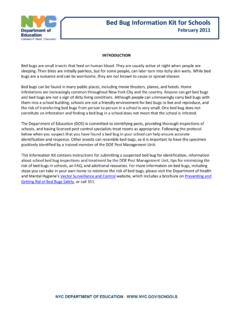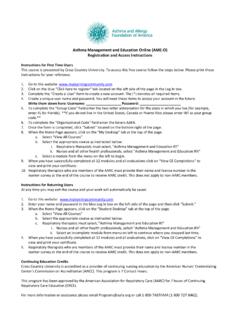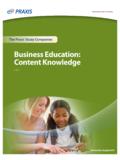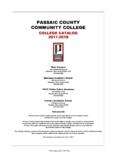Transcription of In Press Academy of Management Learning & Education
1 A PLURALIST CONCEPTUALIZATION OF SCHOLARLY IMPACT IN Management . Education : STUDENTS AS STAKEHOLDERS. HERMAN AGUINIS. The George Washington University, Washington, DC. RAVI S. RAMANI. Purdue University Northwest, Hammond, Indiana NAWAF ALABDULJADER. Kuwait University, Kuwait City, Kuwait JAMES R. BAILEY. The George Washington University, Washington, DC. JOOWON LEE. The George Washington University, Washington, DC. We thank Steven Charlier and three Academy of Management Learning and Education reviewers for offering highly constructive feedback that allowed us to improve our article substantially. A previous version of this article was presented at the Management Education and Development (MED) Plenary Session showcasing the four finalists for the MED Best Paper Award at the meetings of the Academy of Management (Chicago, 2018).
2 Also, a much shorter version excluding all tables was published in the 2018 Academy of Management Best Paper Proceedings. In Press Academy of Management Learning & Education 1. Abstract Scholarly impact is typically conceptualized and measured as an internal exchange that occurs among researchers in the form of citations in journal articles. We offer an expanded conceptualization and measurement of scholarly impact by investigating knowledge transfer to a critical Management Education constituency: students. To do so, we investigated which sources ( , peer-reviewed journals, business periodicals); individual items ( , journal articles, book chapters); and authors are most frequently cited in 38 widely used organizational behavior, human resource Management , strategic Management , and general Management undergraduate- level textbooks.
3 By extracting all endnotes and references, we created a database including 7,445. sources, 33,719 articles and book chapters, and 32,981 authors cited at least once. Results showed a weak relationship between journals, articles, and authors cited most frequently in journals and those most frequently cited in textbooks. We also found that students are exposed to knowledge and content originating both in academic and non-academic outlets. Results have implications for theory and practice regarding the science practice gap and a consideration of students as stakeholders, the conceptualization and measurement of scholarly impact and the design of academic performance Management and reward systems, and choices regarding what knowledge academics create and disseminate. Keywords: Scholarly impact, science practice gap, business schools, Management Education , faculty performance Management , textbooks, higher Education , students as stakeholders 2.
4 For Management professors, a clear way to have scholarly impact is through knowledge transfer ( ,KT; Doh, 2009). KT refers to the dissemination of valuable information to relevant stakeholders ( , Argote & Ingram, 2000). Moreover, academics' ability to create and disseminate relevant knowledge that addresses important questions concerns not only Management professors, but also business school deans, department chairs, and the general public (Adler & Harzing, 2009; Doh, 2009). As an indicator of scholarly impact, KT has traditionally and most commonly been operationalized as the number of times a given journal, paper, or author is cited in academic journals (Adler & Harzing, 2009; Aguinis, Shapiro, Antonacopoulou, & Cummings, 2014; Aguinis, Su rez-Gonz lez, Lannelongue, & Joo, 2012). Although clearly informative, useful, and certainly necessary, traditional measures of scholarly impact have been applied almost exclusively to internal KT; that is, transfer between academics via scholarly journals.
5 As stated by Aguinis et al. (2014: 624), [t]he majority of inquiry on scholarly impact has focused almost exclusively on one particular stakeholder and one type of measure: academics and citations. In other words, the operationalization of KT as citations in scholarly journals does not necessarily consider the scholarly impact of research on other critical stakeholders such as students (Aguinis et al., 2012; Aguinis et al., 2014;. Birkinshaw, Lecouna, & Barwise, 2016; Frost & Taylor, 1996). Our article embraces a pluralistic approach to defining and assessing scholarly impact by examining KT as an external in addition to internal exchange. In doing so, we ask: Is internal scholarly impact similar to external scholarly impact? To answer this question, we build upon but move beyond traditionally used conceptualizations, measures, and implications of KT by investigating what sources ( , scholarly journals, edited books, popular- Press publications).
6 Individual items ( , articles, book chapters); and authors and universities are impactful in some 3. of the most widely used introductory Management textbooks. This novel approach to KT asks whether the knowledge that researchers produce reaches Management students stakeholders who are end-users of scholarly knowledge. Unlike journal articles, which are primarily exchanged within specialized research communities, textbooks influence the knowledge base of large numbers of students who are future practitioners. Also, because most business school students, and particularly Management majors, enroll in an introductory organizational behavior (OB), human resource Management (HRM), strategic Management (SM), or general Management (GM) course during their undergraduate studies, textbooks are their first in-depth exposure to the field of Management and its micro ( , OB and HRM) and macro (SM) perspectives.
7 As noted by Cummings and Bridgman (2016: 252), textbooks play an essential role in codifying and disseminating the foundations and limits of a field. Moreover, an examination of textbooks in the context of external scholarly impact is particularly relevant because practitioners rarely read academic journal articles. For example, Rynes, Colbert, and Brown (2002) found that fewer than 1% of human resource Management practitioners reported that they usually read articles published in Journal of Applied Psychology or Personnel Psychology. Our article is structured as follows: We first provide a brief review of the KT literature and trace the introduction and application of scholarly impact conceptualizations and measures. We attest that because KT is typically evaluated via internal exchange, scholarly impact on other stakeholders, particularly in Management Education , remains largely unknown.
8 We then offer a novel perspective and broader assessment on the state of KT and scholarly impact by analyzing citations in 38 introductory Management textbooks. We emphasize that our approach is not a zero-sum game in which external scholarly impact is achieved at the expense of internal 4. scholarly impact or vice versa. On the contrary, our goal is to broaden the conceptualization and assessment of KT while improving our understanding of scholarly impact. Specifically, by analyzing citations extracted from introductory textbooks, we draw implications for theory and practice regarding the science practice gap and a consideration of students as stakeholders, the conceptualization and measurement of scholarly impact and the design of academic performance Management and reward systems, and choices regarding what knowledge academics create and disseminate.
9 SCHOLARLY IMPACT AND KNOWLEDGE TRANSFER. Within the field of Management , KT is most commonly studied in the form of scholarly impact, which is typically operationalized as the number of citations in subsequently published academic journals (Aguinis et al., 2012, Aguinis et al., 2014). Scholarly impact can be applied at many levels of analysis to understand the influence of a given article, the contribution of a given scholar, the prestige of a given journal, and the reputation of a given university all through citation counts in academic journals (Ryazanova, McNamara, & Aguinis, 2017). Indeed, this metric is particularly appropriate when measuring internal KT ( , impact on the academic community). However, as noted by Aguinis et al. (2012) and Shapiro (2017), this metric does not adequately capture external KT scholarly impact on stakeholders other than researchers.
10 So, there is a need to expand the conceptual definition and measurement of scholarly impact so that KT can be more broadly understood and placed into policies and practices such as faculty performance Management and reward systems (Bailey, 2006). The Science Practice Gap An issue directly related to the conceptualization of scholarly impact is the science practice gap, which is a disconnect between the knowledge that researchers are producing and the knowledge 5. that practitioners are consuming (Cascio & Aguinis, 2008; Jackson, Schuler, & Jiang, 2014;. Rynes, 2007). Concern regarding the science practice gap is not new and has been a matter of discomfort in the Academy for some time ( , Anderson, 2007; Bartunek & Rynes, 2014;. Hambrick, 1994; Pettigrew, 2011; Pfeffer & Fong, 2002). In fact, several former Academy of Management presidents have referred to this gap in their presidential addresses ( , DeNisi, 2010; Hambrick, 1994; Hitt, 1998; Mowday, 1997).






